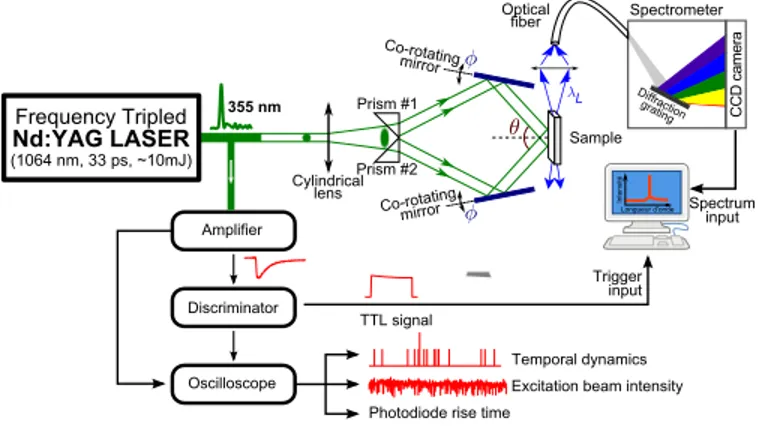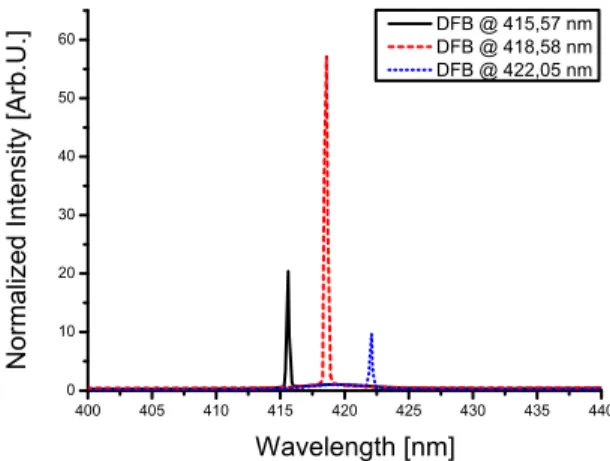HAL Id: cea-02509558
https://hal-cea.archives-ouvertes.fr/cea-02509558
Submitted on 16 Mar 2020
HAL is a multi-disciplinary open access
archive for the deposit and dissemination of
sci-entific research documents, whether they are
pub-lished or not. The documents may come from
teaching and research institutions in France or
abroad, or from public or private research centers.
L’archive ouverte pluridisciplinaire HAL, est
destinée au dépôt et à la diffusion de documents
scientifiques de niveau recherche, publiés ou non,
émanant des établissements d’enseignement et de
recherche français ou étrangers, des laboratoires
publics ou privés.
Amplification of the luminescence response in organic
materials exposed to ionizing radiation
Maugan Michel, Licinio Rocha, Matthieu Hamel, Stéphane Normand
To cite this version:
Maugan Michel, Licinio Rocha, Matthieu Hamel, Stéphane Normand. Amplification of the
lumi-nescence response in organic materials exposed to ionizing radiation: A new method for ionizing
radiation detection. 2012 IEEE Nuclear Science Symposium and Medical Imaging Conference (2012
NSS/MIC), Tom K. Lewellen, University of Washington Medical Center, Oct 2012, Anaheim, United
States. pp.1753-1755, �10.1109/NSSMIC.2012.6551410�. �cea-02509558�
Amplification of the Luminescence Response in
Organic Materials Exposed to Ionizing Radiation
-A New Method For Ionizing Radiation Detection
Maugan Michel, Licinio Rocha, Matthieu Hamel and St´ephane Normand.
Abstract—Polymer-based scintillators present interesting fea-tures for the field of ionizing radiation detection, related to the high sensitivity of fluorescence techniques coupled to their manufacturing advantages. Organic materials can indeed be manufactured into large sensing areas with different geometrical conformations through low-cost fabrication techniques.
Widely used for sensing applications because of its high sensitivity, fluorescence has yet been further improved using technologies yielded by research in photonics. It has already been shown that the use of nanostructuration for sensing applications enables previously unattained precision.
Here we propose a new technique based on the manipulation of light using nanostructuration of the detection medium in order to enable the amplification of the sensitive material emission. This amplification of the scintillation signal is aimed at reducing the detection limit of low-energy beta emitters such as tritium, well-known issue of major importance.
The first step of our study, presented here, consists in demon-strating the ability of well known scintillators to emit in laser regime when optically excited in a Distributed Feedback scheme. They are, to our knowledge, the first of their kind.
The technique here presented, being usable, whatever the sample maximum emission wavelength, should also enable a simplification of the devices based on scintillators.
Index Terms—Ionizing radiation, Detection, Efficiency.
I. INTRODUCTION
C
ONTROLLING light in dielectric materials is an impor-tant field of photonics. Widely studied for communica-tion technologies, nano-modificacommunica-tion of the material properties have found applications in fields ranging from lab-on-chip devices [1] to Martian exobiology [2].Inducing a periodic variation in a dielectric material’s prop-erties in the optical wavelength scale can modify the material’s behaviour towards light. Thus inducing gain, refractive index, or topology gratings can change the generation, absorption and propagation of light in the modulated medium. Following diffraction of light propagating in periodic media, privileged light channels can for example be defined. Combined with a primary light amplification phenomenon, in specific struc-tures, great amplification can occur. Interaction of light with
Corresponding author. Tel: +33 1 69 08 25 27, E-mail address: maugan.michel@cea.fr (M. Michel)
Manuscript received November 15, 2012.
M. Michel is with CEA, LIST, Laboratoire Capteurs et Architectures ´
Electroniques, F-91191 Gif-sur-Yvette, France. Telephone: 33 1 69 08 25 27, e-mail: maugan.michel@cea.fr).
L. Rocha, M. Hamel and S. Normand are with the CEA, LIST, Laboratoire Capteurs et Architectures ´Electroniques, F-91191 Gif-sur-Yvette, France. E-mail: licinio.rocha@cea.fr, stephane.normand@cea.fr
nanostructured media can thus be implemented to design devices that are highly sensitive to any modification of the environment, with strong potential for detecting devices [3], [4].
II. CONTROLLINGLIGHTTHROUGHNANOSCALE
STRUCTURATION– LASEREMISSION INSCINTILLATORS
Population inversion, required so as to emit stimulated radiation [5] can be produced in conjugated molecules, through their π-delocalized electrons. Scintillators, containing such molecules could thus be used as lasing medium.
Appart from the cost reduction due to the use of organic compounds, these materials come with various permanent nanostructuration techniques, also cost effective. The device used for this study, seen in Fig. 2, generates transient gratings enabling real-time control of the periodic structures character-istics.
The diffraction of light in particular gratings can produce Distributed Feedback (DFB) laser emission in which the diffracted beam contra-propagates in the grating, exchanging energy with the propagating wave [6] all along the grating. Provided sufficient gain and excitation, the ensuing resonant structure provides an amplification in the material resulting in a laser emission (see Fig. 1). The emitted wavelength λemfor
this lasing condition to be verified, called the Bragg condition, is calculated using Eq. (1):
λem=
2neffΛ
p (1)
Where neff the effective refractive index of the medium
where the grating exists and p the diffraction order.
One method to achieve a refractive index grating is by using the Kerr effect. It is a non-linear optical effect taking place when high-amplitude polarization variation occurs in a dielectric medium. Through Eq. (2), it appears that through a change of light intensity, one can create a spatially modulated refractive index ∆n, given by Eq. (2):
∆n = ne− no= λKE2 (2)
Where ne, no and K being the extraordinary and ordinary
refractive index and the Kerr constant, respectively. A transient refractive index grating can easily be achieved by making two coherent beams of wavelength λexcinterfere at an angle θ in a
Fig. 1. Conventional (left) and Distributed Feedback (right) lasers’ feed-back schemes. While feedfeed-back in the gain medium (undergoing stimulated emission) in conventional lasers is provided by the mirrors, in a Distributed Feedback scheme, it occurs all along the grating.
Fig. 2. Schematic of the dynamic Distributed Feedback grating experimental setup. The intereference pattern creates two gratings at the same time: Prisms are UV-grade silica. Corotation angle of the mirrors is controlled through a linear translation stage.
Materials are excited with the second (532 nm) or third (355 nm) harmonics of a picosecond Nd3+:YAG laser.
Fig. 3. Index and gain gratings created by the interference pattern of two coherent beams in a material.
presented in Fig. 2. The period Λ of the grating is calculated using Eq. (3):
Λ = λexc
2 sin θ (3)
As well as a refractive index grating, a gain grating is also created thanks to the periodic illuminance (see Fig. 3)
It appears from Eq. (3) that the emission wavelength is directly related to the beams intersection angle. Thus, changing the angle of the corotating mirrors enables continuous tuning of the emitted photon wavelength. Since there is a feedback between polarization of the medium and the propagating electromagnetic wave, it can be said that light can interact with light and thus control it[7].
Fig. 4 shows the molecular structure of the widely used Rhodamine 6G (Rh6G) laser dye, as well as its emission
Fig. 4. Fluorescence and Distributed Feedback spectra and structure of Rhodamine 6G in Ethanol (5·10−3M). Fluorescence spectrum was measured
using a Fluoromax4 spectrofluorometer (HORIBA), λexc = 357 nm. DFB
excitation beam: 10 mJ doubled (532 nm) Nd3+:YAG laser.
(photoluminescence) and a typical emission spectrum once the DFB conditions are verified. Along with the laser peak typically being one to two orders of magnitude more intense than the photoluminescence maximum, independently from the excitation beam intensity. Its full-width at half-maximum is approximately 0.5 nm.
III. DISTRIBUTEDFEEDBACK LASING OF COMMERCIAL LIQUID SCINTILLATORS
As seen in Fig. 2, using a 10 mJ pulsed Nd3+:YAG laser (1064 nm), an interference pattern is created in the sample, simultaneously generating gain and refractive index gratings.
The samples that are to be studied are Ultima GoldTM AB (PerkinElmer, UGAB) and NE-213/BC-501A (Saint-Gobain Crystals), both widely used commercial liquid scintillators. Considering their absorption spectra, their excitation is ob-tained by frequency-tripling the Nd3+:YAG laser (λ = 355 nm), allowing stimulated emission of these samples, thus lasing when the Bragg condition is verified.
As can be seen from Figs. 5 and 6, although not designed for this purpose, we report Distributed Feedback (DFB) lasing for both samples. The tuning of the DFB laser wavelength of Ultima GoldTMAB ranges over at least 40 nm (from 395.2 nm to 435.6 nm). Also clearly appears the important amplification due to DFB when beam intersection is optimum. The ratio between DFB and stimulated emission peaks intensities, DFBSE is a good indicator of this amplification; values of 24 and 65 for Ultima GoldTM AB and BC-501A respectively have been reached.
IV. CONCLUSION
The results presented here were obtained using commer-cial liquid scintillators, which are not initially designed for laser applications. Laser emission has been demonstrated in scintillators using transient gratings. Other nanostructuration techniques are already being investigated.
The results of our preliminary investigation show promising features for the future of scintillating detectors. The results re-garding the effect of ionizing radiation on distributed-feedback lasing will soon be published.
Fig. 5. Variation of the DFB peak wavelength vs. corotation linear stage position for Ultima GoldTM AB . The interfering angle is directly linked to the the position of the linear translation stage (coupled to both mirror’s axes). The decrease in peak intensity circa 428 nm is due to non-optimized structuration. DFB excitation beam: 10 mJ tripled (355 nm) Nd3+:YAG laser.
Fig. 6. Variation of the DFB peak wavelength vs. corotation linear stage position for BC-501A. DFB excitation beam: 10 mJ tripled (355 nm) Nd3+:YAG laser.
REFERENCES
[1] M. Gersborg-Hansen and A. Kristensen, “Optofluidic third order distributed feedback dye laser,” Applied Physics Letters, vol. 89, no. 10, p. 103518, 2006. [Online]. Available: http://link.aip.org/link/?APL/89/103518/1
[2] P. Coll, M. Cabane, P. Mahaffy, and W. Brinckerhoff, “Sample analysis at Mars,” in 35th COSPAR Scientific Assembly, vol. 35, 2004, p. 3605. [Online]. Available: http://msl-scicorner.jpl.nasa.gov/Instruments/SAM/ [3] W. Zeller, L. Naehle, P. Fuchs, F. Gerschuetz, L. Hildebrandt, and
J. Koeth, “DFB Lasers Between 760 nm and 16 micrometer for Sensing Applications,” Sensors, vol. 10, no. 4, pp. 2492–2510, 2010. [Online]. Available: http://www.mdpi.com/1424-8220/10/4/2492/
[4] A. Rose, Z. Zhu, C. F. Madigan, T. M. Swager, and V. Bulovic, “Sensitivity gains in chemosensing by lasing action in organic polymers,” Nature, vol. 434, no. 7035, pp. 876–879, Apr 2005, attenuated lasing in optically pumped SOP thin films displays a sensitivity to vapours of explosives more than 30 times higher than is observed from spontaneous emission.
[5] A. Einstein, “Zur Quantentheorie der Strahlung,” Physikalische Zeitschrift, vol. 18, pp. 121–128, 1917.
[6] H. Kogelnik and C. V. Shank, “Stimulated emission in a periodic structure,” Applied Physics Letters, vol. 18, no. 4, pp. 152–155, February 1971.
[7] G. Boulon, “G´en´eration dimpulsions lasers ultracourtes jusqu`a la femtoseconde,” Techniques de l’ing´enieur., vol. AF3282, no. AF3282, pp. 1–24, 2006. [Online]. Available: http://www.techniques-
ingenieur.fr/base-documentaire/sciences-fondamentales-th8/physique- chimie-ti053/generation-d-impulsions-lasers-ultracourtes-jusqu-a-la-femtoseconde-af3282/

